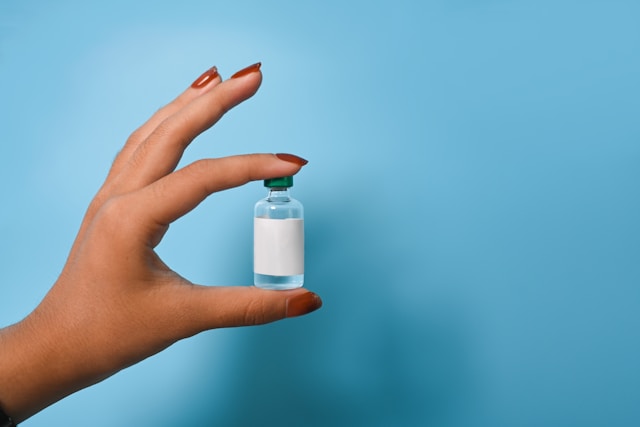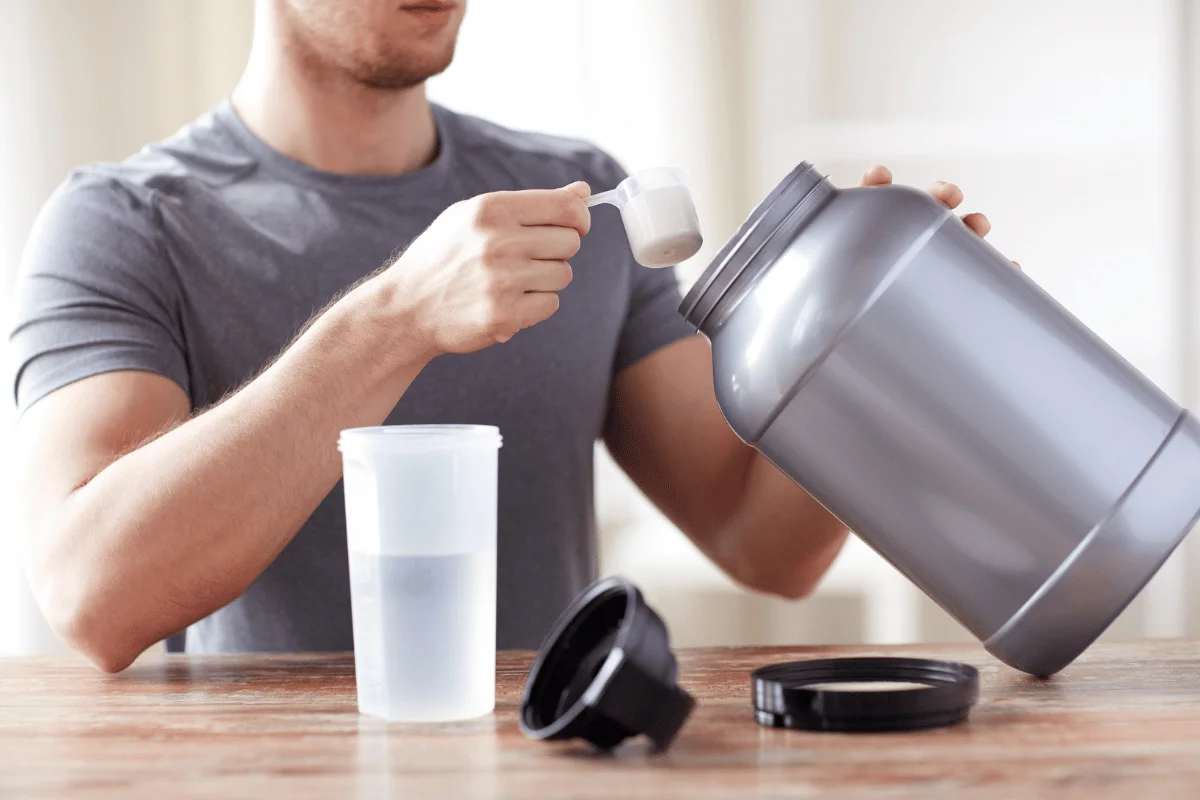This article is for informational purposes only and does not constitute medical advice. Always consult with a qualified healthcare provider before considering any peptide therapy.
Follistatin-344 is one of the most extensively studied myostatin inhibitors in muscle biology. It has been the subject of preclinical research for several decades, and the preclinical data consistently demonstrates dramatic effects on muscle mass and strength.
In animal models, increases in muscle mass of greater than 100% have been consistently reported, and early clinical trials in patients with muscular dystrophy showed functional benefits.
However, there continues to be a large translational gap between laboratory findings and real-world applications, and some of the concerns around clinical outcomes are well founded, including legitimate safety concerns for reproductive, vision, and cancer effects.
Quick Takeaways
- Follistatin-344 blocks myostatin and activin to remove the natural brake on muscle growth, with animal studies showing 60-150% increases in muscle mass
- Human clinical trials in muscular dystrophy patients showed modest functional gains, but lacked placebo controls and were later acknowledged by researchers as disappointing compared to expectations
- High-dose misuse has caused central serous chorioretinopathy (vision impairment) in bodybuilders, and new research suggests efforts to increase muscle through myostatin inhibition may reduce fertility by lowering FSH levels by 75%
- More than half of black market follistatin products either contain no follistatin or are contaminated with bacterial expression tags and other growth peptides
What is Follistatin 344?
Follistatin-344 is one of three natural glycoprotein hormones that regulate muscle growth, alongside follistatin-288 and follistatin-315. After secretion, it is cleaved into follistatin-315, which circulates in the bloodstream.
Follistatin-344 binds to activin less tightly than the membrane-bound 288 isoform, making it more suitable for localized muscle applications. It has been studied using three methods of administration: recombinant protein injection, mRNA encoding, and AAV1 gene therapy[1].
How Does Follistatin 344 Work?
Follistatin-344 functions as a binding protein designed to inhibit myostatin and activin, two members of the TGF-β superfamily that suppress muscle development.
When follistatin captures these molecules, it prevents them from binding to activin type II receptors on muscle cells. This blocks the SMAD signaling cascade that normally limits protein synthesis and cell growth. Dr. Se-Jin Lee, who discovered myostatin in 1997, described the effect simply: “These mice have a doubling of muscle mass throughout the body.”
Follistatin promotes muscle growth through multiple pathways:
- Myostatin blockade – Prevents the primary negative regulator of muscle mass from suppressing growth signals
- Activin neutralization – Blocks a second growth-limiting factor that activates similar suppression pathways
- mTOR activation – Triggers the Akt/mTOR/S6K cascade that drives protein synthesis independent of myostatin
- Satellite cell recruitment – Activates muscle precursor cells to add new nuclei and support hypertrophy
Studies in myostatin-null mice proved follistatin still produces hypertrophy even when myostatin is completely absent, confirming these additional mechanisms matter.
Third-Party Tested, 99% Purity
Order lab-verified peptides from our top recommended vendor.

Muscle Growth Benefits of Follistatin 344
Research evidence for follistatin’s muscle-building effects comes from three types of studies with progressively weaker results as you move from mice to primates to humans.
Animal Study Results
Mouse studies consistently show the most dramatic effects. A single AAV1-FS344 injection produced muscle gains lasting over two years in aged mice. Local muscle injections more than doubled treated muscle mass within 28 days[2].
Systemic delivery increased limb muscle force capacity by 60% in wild-type mice. Fiber area grew 11-13% in some muscles and 23% in others after 13 weeks, with pronounced gains in skeletal muscle mass.
The dystrophic mdx mouse model showed even better responses. Muscle fiber diameters increased 34%, while serum creatine kinase (a muscle damage marker) dropped 50%. Researchers also observed reduced necrosis in muscle tissue and less fibrosis.
Non-Human Primate Data
The pivotal cynomolgus macaque study provided the most relevant translational data before human trials. Monkeys received bilateral quadriceps injections of AAV1.CMV.FS344 at 1 × 10¹³ vector genomes total dose[3].
Quadriceps circumference increased 15% at 8 weeks and maintained these gains through 60 weeks without loss, demonstrating sustained improvements in muscle size and strength. Mean muscle fiber diameter grew from 65.5 μm in controls to 87.7 μm in treated animals, a 34% increase. Tissue follistatin levels exceeded 20 ng/mg at both 5 and 15 months post-injection.
| Study Model | Muscle Mass Increase | Force Improvement | Duration |
|---|---|---|---|
| Normal mice | 100-150% | 40-60% | 28 days to 2 years |
| Dystrophic mice | 34% fiber diameter | Not measured | 13+ weeks |
| Macaque monkeys | 15% circumference | Not measured | 60+ weeks |
Human Clinical Trials
Six patients with Becker muscular dystrophy received AAV1.CMV.FS344 at 6 × 10¹¹ vg/kg via bilateral quadriceps injections in the first human trial. The research team reported functional improvements[4].
Dr. Jerry Mendell stated at the time: “This is the first gene therapy clinical trial to show functional improvement in any form of muscular dystrophy.”
Yet a 2017 critique challenged these findings, noting the lack of placebo controls and potential performance bias from patient awareness. By 2022, Mendell himself acknowledged: “We tried follistatin or myostatin inhibition, and that didn’t work well.”
A follow-up trial in sporadic inclusion body myositis treated nine patients with similar methodology but faced the same methodological limitations.
Beyond Muscle
Research suggests follistatin may affect multiple physiological systems beyond skeletal muscle:
- Anti-inflammatory effects – Studies show a 10 μg dose decreased TNF release by 50% and IL-1β by 65% in endotoxemia models[5]
- Metabolic regulation – Early data suggests β-cell proliferation in pancreatic islets may improve insulin secretion[6]
- Bone formation – Preliminary research indicates possible increases in bone density through activin and myostatin inhibition[7]
- Hair growth – One pilot study reported 13% improvements in hair follicle thickness over one year[8]
These findings remain preliminary and require replication in controlled human trials.
Can You Naturally Boost Follistatin Levels?
Research shows several lifestyle interventions can increase endogenous follistatin production, though effects remain modest compared to pharmacological dosing.
Resistance Training
Exercise triggers the most reliable increases in circulating follistatin. One study found plasma follistatin increased 7-fold after three hours of cycling, with levels peaking during recovery[9].
Resistance training appears particularly effective:
- Compound movements (squats, deadlifts, bench press) that recruit large muscle groups produce the greatest response
- Eccentric contractions (muscle lengthening under load) cause significant muscle damage that triggers robust follistatin release
- Effects persist for several days after training sessions
Epicatechin Supplementation
Epicatechin, a flavanol found in dark chocolate and cocoa, shows the strongest dietary evidence for boosting follistatin levels. Human studies demonstrate:
- 170 mg daily (2 mg/kg bodyweight) increased follistatin by 49% and decreased myostatin 16.6% after seven days[10]
- 50-200 mg daily raised follistatin levels 250% after just five days in some subjects[10]
- Hand grip strength improved 7% alongside favorable follistatin/myostatin ratio changes
- Eight-week supplementation with resistance training produced the greatest increases in follistatin and strength[11]
Dietary sources include dark chocolate (highest concentration), cocoa powder, and green tea, though supplementation provides more consistent dosing.
Fasted Training
Healthy men who exercised in a fasted state (no food beforehand) showed larger increases in follistatin levels compared to fed training[9]. Combining strength workouts with intermittent fasting may amplify the follistatin response.
Your body naturally produces follistatin in the liver, skeletal muscle, and other tissues. Levels decline with age while myostatin increases, contributing to age-related muscle loss.
While these natural methods can improve the follistatin/myostatin balance, none approach the dramatic effects seen with gene therapy or high-dose injections.
💡PEPTIDE PICKS: MORE TO EXPLORE
- Interested in safer muscle-building options? Discover the best peptides for bodybuilding with stronger human evidence and fewer safety concerns than follistatin.
- Wondering how peptides stack up against traditional performance enhancers? We compare the science in peptides vs steroids to help you understand the trade-offs.
- Looking for male-focused peptide protocols? Check out our guide to peptides for men covering testosterone support, muscle building, and anti-aging applications.
Side Effects of Follistatin 344
Safety data comes primarily from gene therapy trials using controlled doses of the FS-344 isoform, while most documented side effects involve black market products and high-dose misuse.
Reproductive Effects
Follistatin’s role in the activin-inhibin axis raised early concerns about fertility. Yet two-year reproductive studies in FS-344 treated mice showed normal litter sizes and no gonadal tissue changes[2].
Recent research published in 2025 changes this picture. The groundbreaking study revealed that muscle-derived myostatin, not activin, drives follicle-stimulating hormone (FSH) synthesis. Treatment with myostatin neutralizing antibodies reduced FSH by 75% within one week and decreased egg ovulation in females[12].
The authors concluded: “Inhibitory effects of any myostatin antagonist on FSH and fertility should be considered, if not anticipated.”
Vision Impairment
A 2020 case series documented 11 male bodybuilders who developed central serous chorioretinopathy (CSCR) after subcutaneous follistatin-344 injections[13]. These cases highlight a dangerous pattern emerging in the bodybuilding community:
- All patients injected complete 1 mg vials (roughly 10 times typical recommended doses)
- 10 patients developed unilateral CSCR, one had bilateral involvement
- Single-injection cases saw complete resolution after an average of 2.3 months
- Three patients with multiple injections developed recurrent episodes
The mechanism remains unclear but may involve increased choroidal blood flow, atherosclerosis promotion, or sodium retention.
Tendon Weakness
Research in myostatin-deficient mice shows weak and brittle tendons, suggesting myostatin plays a role in tendon maintenance[14]. If follistatin blocks myostatin activity long-term, similar tendon issues may develop, though human data is lacking.
Cancer Concerns
Follistatin’s relationship with cancer appears tissue-dependent. In breast cancer, high serum follistatin correlates with better survival and fewer metastases[15]. In prostate cancer, the opposite may be true, as activin normally inhibits cell proliferation.
A 2019 thymic tumor study found elevated follistatin levels correlated with tumor stage and worse outcomes[16]. The complexity of TGF-β signaling makes cancer risk assessment difficult without long-term human data.
Black Market Contamination
A 2019 analysis of 17 black market follistatin products revealed widespread quality problems[17]:
- Only 9 of 17 products actually contained follistatin
- All nine authentic products had His-tagged FS344 and oligomers (indicating bacterial expression, not pharmaceutical-grade)
- Other vials contained MGF and GHRP-2 instead of follistatin
- Human-grade follistatin costs over $4,500 per milligram, making adulteration economically attractive
These findings suggest more than half of available products are either fake or dangerously contaminated.
Follistatin 344 Dosage
Dosing varies dramatically based on delivery method and intended application, with no approved human protocols outside clinical trials.
Clinical Trial Doses
Human muscular dystrophy trials used AAV1.CMV.FS344 at 6 × 10¹¹ vg/kg for Becker patients and proposed 2.4 × 10¹² vg/kg for Duchenne patients. Gene therapy provides sustained expression for 15+ months after a single treatment[4].
The macaque study used 1 × 10¹³ vector genomes total (approximately 3.3 × 10¹² vg/kg) via bilateral intramuscular quadriceps injections.
Recombinant Protein
Mouse studies used 0.5-0.75 mg/kg recombinant protein subcutaneously once or twice daily. Yet recombinant follistatin has a poor 90-minute half-life and rapid liver clearance, limiting practical applications.
mRNA-based delivery shows serum levels peaking at 19.9 ng/mL at 8 hours but returning to baseline by 96 hours, suggesting dosing every 72 hours if this route were used.
Black Market Protocols
Underground sources typically describe 100 mcg per day administered subcutaneously or intramuscularly for cycles of 10-30 days. One commercial product recommends 50-100 μg once daily for 10-30 days followed by a 30-day pause.
The CSCR case series involved 1 mg injections, 10 times these typical doses. Standard vendor recommendations suggest 100 mcg daily, making one 1 mg vial last 10 days.
| Delivery Method | Dose Range | Frequency | Duration |
|---|---|---|---|
| AAV1 gene therapy | 6-24 × 10¹¹ vg/kg | Single injection | 15+ months |
| Recombinant protein | 0.5-0.75 mg/kg | 1-2x daily | Ongoing |
| Black market (reported) | 50-100 mcg | Once daily | 10-30 days |
Bottom Line
Follistatin-344 produces dramatic muscle gains in mice and monkeys, with some studies showing 100%+ increases in muscle mass. The science behind myostatin inhibition is solid.
Human results tell a different story. Clinical trials lacked placebo controls, showed modest benefits, and the lead researcher later admitted the approach “didn’t work well.” High-dose misuse causes vision problems that take months to resolve. New research suggests myostatin inhibitors may reduce fertility by dropping FSH levels 75%.
More than half of black market products are fake or contaminated. Pharmaceutical-grade follistatin costs over $4,500 per milligram. While muscle growth peptides remain an active research area, follistatin-344 sits in the category of promising animal data that hasn’t translated to safe, effective human use.
References
- Rodino‐Klapac LR, Haidet AM, Kota J, Handy C, Kaspar BK, Mendell JR. Inhibition of myostatin with emphasis on follistatin as a therapy for muscle disease. Wiley; 2009. https://doi.org/10.1002/mus.21244
- Haidet AM, Rizo L, Handy C, Umapathi P, Eagle A, Shilling C, et al. Long-term enhancement of skeletal muscle mass and strength by single gene administration of myostatin inhibitors. Proceedings of the National Academy of Sciences; 2008. https://doi.org/10.1073/pnas.0709144105
- Kota J, Handy CR, Haidet AM, Montgomery CL, Eagle A, Rodino-Klapac LR, et al. Follistatin Gene Delivery Enhances Muscle Growth and Strength in Nonhuman Primates. American Association for the Advancement of Science (AAAS); 2009. https://doi.org/10.1126/scitranslmed.3000112
- Mendell JR, Sahenk Z, Malik V, Gomez AM, Flanigan KM, Lowes LP, et al. A Phase 1/2a Follistatin Gene Therapy Trial for Becker Muscular Dystrophy. Elsevier BV; 2015. https://doi.org/10.1038/mt.2014.200
- Jones KL, Mansell A, Patella S, Scott BJ, Hedger MP, de Kretser DM, et al. Activin A is a critical component of the inflammatory response, and its binding protein, follistatin, reduces mortality in endotoxemia. Proceedings of the National Academy of Sciences; 2007. https://doi.org/10.1073/pnas.0705971104
- Zhao C, Qiao C, Tang RH, Jiang J, Li J, Martin CB, et al. Overcoming Insulin Insufficiency by Forced Follistatin Expression in β -cells of db/db Mice. Elsevier BV; 2015. https://doi.org/10.1038/mt.2015.29
- Fahmy-Garcia S, Farrell E, Witte-Bouma J, Robbesom-van den Berge I, Suarez M, Mumcuoglu D, et al. Follistatin Effects in Migration, Vascularization, and Osteogenesis in vitro and Bone Repair in vivo. Frontiers Media SA; 2019. https://doi.org/10.3389/fbioe.2019.00038
- Zimber M, Ziering CL, Zeigler F, Hubka M, Mansbridge J, Baumgartner M, et al. Hair regrowth following a Wnt- and follistatin containing treatment: safety and efficacy in a first-in-man phase 1 clinical trial. Journal of Drugs in Dermatology 2011;10 11:1308–12.
- Hansen J, Brandt C, Nielsen AR, Hojman P, Whitham M, Febbraio MA, et al. Exercise Induces a Marked Increase in Plasma Follistatin: Evidence That Follistatin Is a Contraction-Induced Hepatokine. The Endocrine Society; 2011. https://doi.org/10.1210/en.2010-0868
- Gutierrez-Salmean G, Ciaraldi TP, Nogueira L, Barboza J, Taub PR, Hogan MC, et al. Effects of (−)-epicatechin on molecular modulators of skeletal muscle growth and differentiation. Elsevier BV; 2014. https://doi.org/10.1016/j.jnutbio.2013.09.007
- Mafi F, Biglari S, Ghardashi Afousi A, Gaeini AA. Improvement in Skeletal Muscle Strength and Plasma Levels of Follistatin and Myostatin Induced by an 8-Week Resistance Training and Epicatechin Supplementation in Sarcopenic Older Adults. Human Kinetics; 2019. https://doi.org/10.1123/japa.2017-0389
- Ongaro L, Zhou X, Wang Y, Schultz H, Zhou Z, Buddle ERS, et al. Muscle-derived myostatin is a major endocrine driver of follicle-stimulating hormone synthesis. American Association for the Advancement of Science (AAAS); 2025. https://doi.org/10.1126/science.adi4736
- Dağ U, Çağlayan M, Öncül H, Alakuş MF. Central serous chorioretinopathy associated with high-dose follistatin-344: a retrospective case series. Springer Science and Business Media LLC; 2020. https://doi.org/10.1007/s10792-020-01501-6
- Eliasson P, Andersson T, Kulas J, Seemann P, Aspenberg P. Myostatin in tendon maintenance and repair. Informa UK Limited; 2009. https://doi.org/10.1080/08977190903052539
- Sosa J, Oyelakin A, Sinha S. The Reign of Follistatin in Tumors and Their Microenvironment: Implications for Drug Resistance. MDPI AG; 2024. https://doi.org/10.3390/biology13020130
- Janik S, Bekos C, Hacker P, Raunegger T, Schiefer AI, Müllauer L, et al. Follistatin impacts Tumor Angiogenesis and Outcome in Thymic Epithelial Tumors. Springer Science and Business Media LLC; 2019. https://doi.org/10.1038/s41598-019-53671-8
- Reichel C, Gmeiner G, Thevis M. Detection of black market follistatin 344. Wiley; 2019. https://doi.org/10.1002/dta.2741








